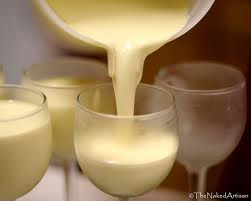For Christmas and New Years you need a holiday beverage of distinction. Here it is.
This eggnog gem is a favorite post on this blog. To make the holidays easy for you, I'm putting right at the top again. It is, without doubt, the best eggnog you've ever had. The holiday season is upon us and eggnog is a treat for memorable meals and parties. Suzi and I have party this Saturday and dessert will consist of this eggnog and something else – Suzi and I are in negotiations about what the "else" will be.
However, I do have some idea. Here's a hint. This eggnog recipe uses 6 egg yolks. That leaves us with 6 egg whites. I'll be blogging some meringue ideas in the next week from a brilliant new book devoted to meringue. Stay tuned. Have your beaters ready.
And, in the meantime, enjoy this very, very, very rich beverage.
Not surprisingly, eggnog has a great history and total variety in how it is made. It’s a dairy-based beverage with milk, cream, sugar, beaten eggs and some kind of liquor. The ingredients can vary and the assembly variations are endless. You always beat the yolk and stiffen some kind of sugar, but some recipes also call for beating the whites separately and folding them in. The cream, or the egg white, is added to thicken the beverage which traditionally is meant to leave some lasting trace on your upper lip. Brandy, rum, or whiskey can be the liquor.
The beverage originated in England. The “nog” in the name probably stems from “noggin,” a small wooden mug used for alcoholic beverages. There was, Wikipedia suggests, a tradition in England of having liquor in the milk all year round because there were very few refrigerators in London in, say, 1700.
I found this recipe by serendipity. For Thanksgiving, I suggested a wonderful Pumpkin Chiffon Cake. It’s an asymmetrical recipe: 8 egg whites and 5 yolks. I had three yolks left over. What do you do then? You google “egg yolk recipes” and you find recipeland.com with 83 pages of egg yolk recipes. I started on page 1. I stopped on page 3. There I found this recipe there for Grandma’s Swinging Eggnog. This recipe is incredible. Make this and you will never, never ever buy eggnog in the dairy section again. This is a “crossing the Rubicon” experience.
I have adjusted the recipe three ways, so I’m sharing my name on it. First, I have doubled the amount of sugar mixed with the egg yolks. I like the additional sweetness and the additional thickness it provides.
Second, instead of using light rum, I used a dark Caribbean rum, one with lots of spicy overtones — which is wise because this recipe itself does not call for dusting with any spices. If you have a bottle of Captain Morgan’s Spiced Rum hidden on that back shelf and you never figured out what to do with it, now you have a positive solution.
And third, when the cream is being whipped, I suggest adding powdered sugar — powdered so that there is no trace of graininess in the whipped cream.
Most recipes for eggnog suggest using a cocktail shaker. Here you need a bowl and a whisk. This drink is made by folding or gently whisking in the whipped cream.
I hope you enjoy every sip.
Brian and Grandma’s Swinging Eggnog
Yield: 8 glasses, more or less
Ingredients:
- 6 large egg yolks
- 1 cup granulated sugar
- 2 cups cold milk
- 2 cups dark, spicy rum
- 2 cups heavy whipping cream
- ¾ cup powdered sugar
Preparation:
Beat the egg yolks until light with a whisk. Continue whisking and slowly add the granulated sugar. Whisk until the mixture is stiffening. If you taste test, there may be some graininess still evident from all that sugar. That will go away with the additional liquids to come.
Add the milk and rum. Mix well, then chill for at least 3 hours.
One hour before serving, whip the cream until medium peaks form. Beat in the powder sugar. Gently fold or whisk the whipped cream into the chilled egg-milk-rum mixture. The goal here is to get a good mix of cream and chilled liquid. You don’t want to deflate the whipped cream. You will end up with a thick consistency with some globs of whipping cream suspended. That’s fine.
Refrigerate for one hour. Then serve.
Source: Brian O’Rourke and recipeland.com

